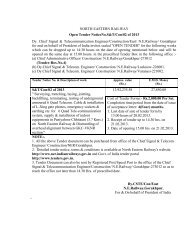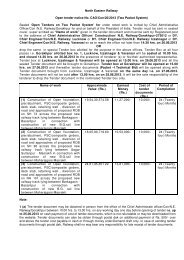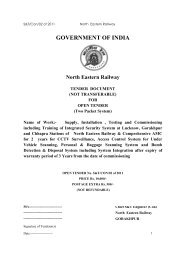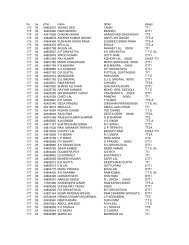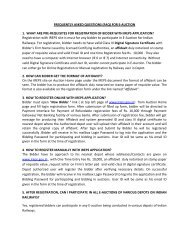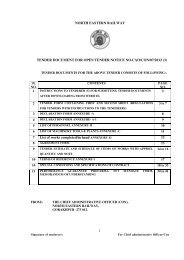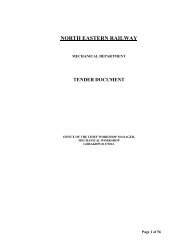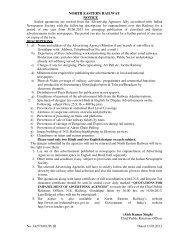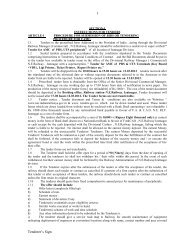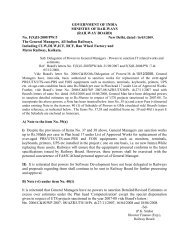GOVERNMENT OF INDIA North Eastern Railway ... - Tenders India
GOVERNMENT OF INDIA North Eastern Railway ... - Tenders India
GOVERNMENT OF INDIA North Eastern Railway ... - Tenders India
You also want an ePaper? Increase the reach of your titles
YUMPU automatically turns print PDFs into web optimized ePapers that Google loves.
Dy.CSTE/Con/ IZN/02 of 2011 <strong>North</strong> <strong>Eastern</strong> <strong>Railway</strong><br />
measurement should be made where necessary. In case of special terrains, the<br />
separation distance at some points on the route may also have to be reckoned<br />
from some other permanent structures depending upon the site conditions.<br />
2.7.8 The separation distance of the cable route from the nearest track on the<br />
"straight runs" should be 10M The deviating from this standard separation of<br />
10M should be kept to the minimum and as soon as any obstruction has been<br />
negotiated, the route should again follow this standard separation distance. It is<br />
desirable from the point of view of calculating the induced voltage that the<br />
uniformity of the separation is maintained for the maximum possible length of<br />
the main cable route.<br />
2.7.9 Separation distance should be marked on the "straight runs" portion of the<br />
cable route plan (5 Km. chart) at intervals of not more than 250 M In addition,<br />
the separation distance at points of change in the cable route such as<br />
diversions, track crossings, approaches to bridges, culverts, etc. should<br />
invariably be marked on the cable route plan in such a way as the intended<br />
cable route is clearly defined for "special terrain" the separation distance<br />
should be marked at as close intervals as is considered necessary depending on<br />
the site conditions.<br />
2.7.10 The route should be decided by walking along the track. On long stretches<br />
"straight runs" a push trolley moving slowly may be used . The trolley should<br />
be on the track closes to the proposed route.<br />
2.7.11 Actual measurement should be made for the protective works required for the<br />
cable passing over the culverts, under tracks, over long girder bridges, level<br />
crossings, rocky areas, under the bed of culverts etc.<br />
2.7.12 Once the cables are laid, the actual length of cable as per the printed marking<br />
on the cable is required to be indicated at every kilometer of cable route, at<br />
diversions, crossings, approaches of bridges and joints for optical & quad<br />
cables.<br />
2.8 FINALISATION <strong>OF</strong> TAPPING DIAGRAM<br />
2.8.1 The survey team should visit each location such as cabin, SM's offices, Loco<br />
sheds, cabins, gate lodges, etc. and verify the details collected during the<br />
preliminary survey of all the existing telecommunication facilities, and<br />
additional telecommunication facilities to be provided.<br />
2.8.2 The position of each tapping should thus be finalized and a final tapping<br />
diagram prepared.<br />
2.9 ISOLATED TELEPHONE CIRCUITS<br />
It is necessary that all the telephone circuits such as isolated quarry sites, gate lodges,<br />
etc. are taken note of and provision made for transferring the overhead alignment into<br />
cables wherever considered necessary.<br />
2.1 LENGTH <strong>OF</strong> <strong>OF</strong>C/6 QUAD CABLE<br />
The cable length is worked out on following basis to arrive at the locations of the<br />
straight joints:-<br />
a) Route length as per actual measurement plus contour allowances of 3.5%.<br />
Signature of Tenderer(s)<br />
Date…………………<br />
40



